
Lectern
Encyclopedia
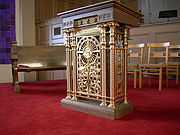
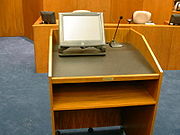


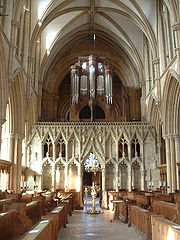
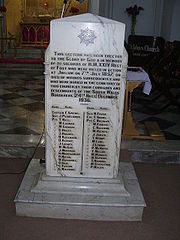
Lecture
thumb|A lecture on [[linear algebra]] at the [[Helsinki University of Technology]]A lecture is an oral presentation intended to present information or teach people about a particular subject, for example by a university or college teacher. Lectures are used to convey critical information, history,...
, or sermon
Sermon
A sermon is an oration by a prophet or member of the clergy. Sermons address a Biblical, theological, religious, or moral topic, usually expounding on a type of belief, law or behavior within both past and present contexts...
. To facilitate eye-contact and improve posture when facing an audience, lecterns may have adjustable height and slant. People generally use lecterns while standing.
Academic context
Lecterns used in academia—generally in seminar rooms and lecture theatres—may have certain features that common lecterns lack, based on the technological sophistication of the venue. These features usually include a microphone stand, audio-visual controls, sometimes even an integrated computer and recording system. Lecterns of this sort are generally attached or integrated into a large desk, as the amount of support material tends to be larger in academic contexts than in straightforward public talks.Religious context
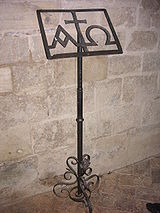
Lecterns are often made of wood. They may be either fixed in place or portable. A lectern differs from a pulpit
Pulpit
Pulpit is a speakers' stand in a church. In many Christian churches, there are two speakers' stands at the front of the church. Typically, the one on the left is called the pulpit...
, the latter being used for sermons
Sermon
A sermon is an oration by a prophet or member of the clergy. Sermons address a Biblical, theological, religious, or moral topic, usually expounding on a type of belief, law or behavior within both past and present contexts...
. Churches that have both a lectern and a pulpit will often place them on opposite sides. The lectern will generally be smaller than the pulpit, and both may be adorned with antipendia in the color of the liturgical season
Liturgical year
The liturgical year, also known as the church year, consists of the cycle of liturgical seasons in Christian churches which determines when feast days, including celebrations of saints, are to be observed, and which portions of Scripture are to be read. Distinct liturgical colours may appear in...
.
In monastic churches and cathedrals, a separate lectern is commonly set in the centre of the choir. Originally this would have carried the antiphonal book, for use by the cantor
Cantor (church)
A cantor is the chief singer employed in a church with responsibilities for the ecclesiastical choir; also called the precentor....
or precentor
Precentor
A precentor is a person who helps facilitate worship. The details vary depending on the religion, denomination, and era in question. The Latin derivation is "præcentor", from cantor, meaning "the one who sings before" ....
leading the singing of the divine office
Divine Office
Divine Office may refer to:* Liturgy of the Hours, the recitation of certain Christian prayers at fixed hours according to the discipline of the Roman Catholic Church* Canonical hours, the recitation of such prayers in Christianity more generally...
. Lecterns are often eagle shaped
Eagle lectern
An eagle lectern is a lectern in the shape of an eagle. They are very common in Christian churches and cathedrals. The eagle is the symbol used to depict John the Apostle, whose writing most clearly witnesses the light and divinity of Christ...
to symbolise John the Apostle
John the Apostle
John the Apostle, John the Apostle, John the Apostle, (Aramaic Yoħanna, (c. 6 - c. 100) was one of the Twelve Apostles of Jesus. He was the son of Zebedee and Salome, and brother of James, another of the Twelve Apostles...
.
Nota Bene
1. A common error among speakers is the mistake of referring to the lectern as a "podium". The podiumPodium
A podium is a platform that is used to raise something to a short distance above its surroundings. It derives from the Greek πόδι In architecture a building can rest on a large podium. Podia can also be used to raise people, for instance the conductor of an orchestra stands on a podium as do many...
is in fact the raised platform upon which both the speaker and the lectern are standing.
Merriam-Webster, however, bows to lecterns and podiums as being synonymous in their definition as popularly confused.
2. The term "rostrum" (a synonym for lectern) is thought to have originated from the Ancient Romans. The "beak" on the front of a Carthaginian navy vessel for ramming enemy ships was called a "rostrum" by the Romans, meaning a bird's beak. The apocryphal tale goes that after defeating the Carthaginians in a naval battle, the rostra were cut off several vessels, and taken back to Rome, where they were used in the Senate for the same purposes as a modern lectern.
See also
- PulpitPulpitPulpit is a speakers' stand in a church. In many Christian churches, there are two speakers' stands at the front of the church. Typically, the one on the left is called the pulpit...
- PodiumPodiumA podium is a platform that is used to raise something to a short distance above its surroundings. It derives from the Greek πόδι In architecture a building can rest on a large podium. Podia can also be used to raise people, for instance the conductor of an orchestra stands on a podium as do many...
- LectorLectorLector is a Latin term for one who reads, whether aloud or not. In modern languages the word has come to take various forms, as either a development or a loan, such as , , and . It has various specialized uses:...
- LectionLectionA lection is a reading, in this context, from Scripture.The custom of reading the books of Moses in the synagogues on the Sabbath day was a very ancient one. The addition of lections from the prophetic books had been made afterwards and was in existence at the time of Jesus, as may be gathered...
- AnalogionAnalogionAn Analogion is a lectern or slanted stand on which icons or the Gospel Book are placed for veneration by the faithful in the Eastern Orthodox Church and Eastern Catholic Churches...
- Eagle lecternEagle lecternAn eagle lectern is a lectern in the shape of an eagle. They are very common in Christian churches and cathedrals. The eagle is the symbol used to depict John the Apostle, whose writing most clearly witnesses the light and divinity of Christ...

